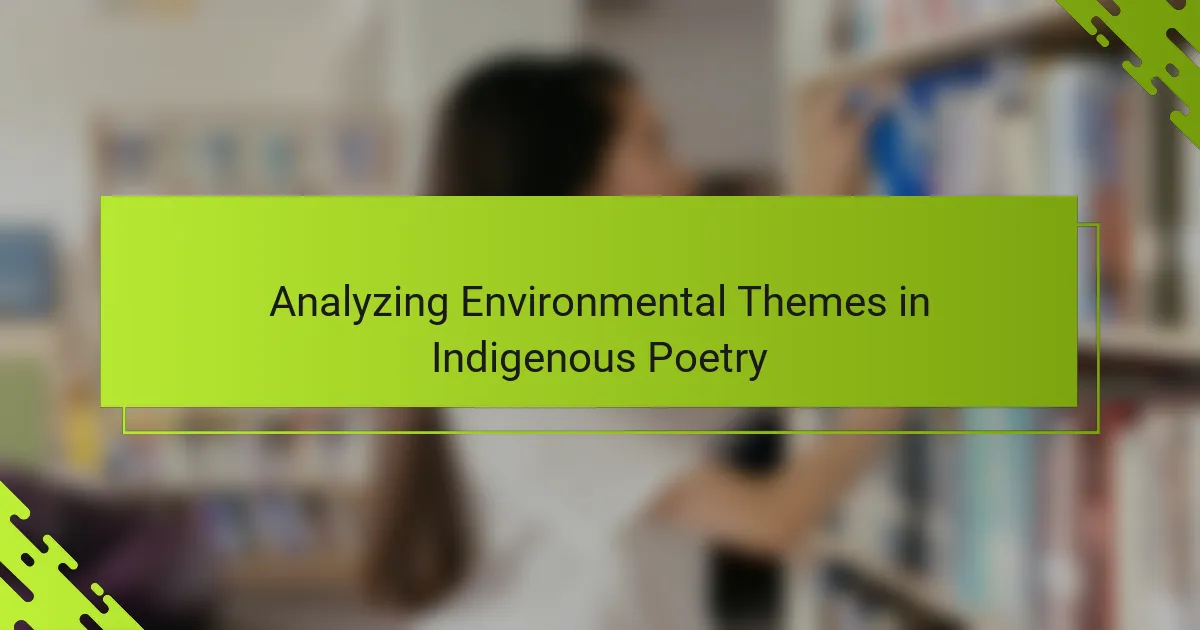Indigenous poetry serves as a powerful medium for expressing environmental themes, highlighting the deep connections between culture and nature. This article explores the significance of stewardship and sustainability, the impact of colonialism on ecosystems, and the unique attributes of Indigenous identity reflected in poetry. It also addresses contemporary issues such as climate change and ecological justice, emphasizing the challenges faced by Indigenous poets in conveying these vital themes. Engaging with this poetry fosters a deeper understanding of Indigenous perspectives and their relationship with the environment.
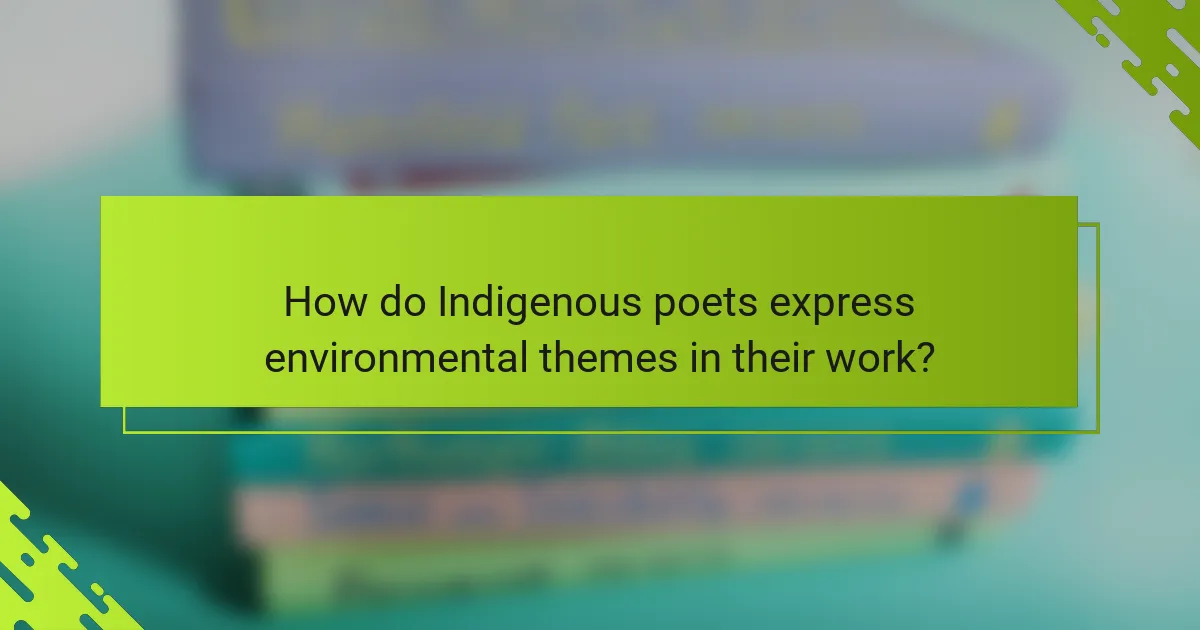
How do Indigenous poets express environmental themes in their work?
Indigenous poets express environmental themes by weaving cultural narratives with deep connections to nature. Their work often emphasizes stewardship, sustainability, and respect for the land. Poets utilize unique imagery and traditional knowledge to highlight the impact of colonization on ecosystems. Through their verses, they advocate for ecological balance and raise awareness about environmental injustices faced by Indigenous communities.
What literary devices are commonly used to convey nature in Indigenous poetry?
Indigenous poetry often employs literary devices such as imagery, metaphor, and personification to convey nature. Imagery vividly paints natural landscapes, while metaphor draws parallels between human experiences and the environment. Personification attributes human qualities to nature, emphasizing interconnectedness. These devices deepen the emotional resonance of environmental themes in Indigenous poetry, reflecting cultural reverence for nature.
How does storytelling shape the representation of environmental issues?
Storytelling significantly shapes the representation of environmental issues by highlighting Indigenous perspectives. These narratives often emphasize the interconnectedness of nature and humanity, fostering a deeper understanding of ecological challenges. Indigenous poetry frequently incorporates unique attributes, such as ancestral knowledge and cultural heritage, which provide valuable insights into sustainable practices. This representation can inspire broader audiences to engage with environmental conservation efforts. As a result, storytelling serves as a powerful tool for raising awareness and promoting action on critical environmental concerns.

What are the cultural significance and connections between Indigenous identity and the environment?
Indigenous identity is deeply connected to the environment, reflecting a holistic worldview. Nature is not merely a backdrop but a vital part of identity, spirituality, and culture. Indigenous poetry often embodies this connection, emphasizing themes of stewardship, respect, and kinship with the land.
The significance of the environment in Indigenous identity is evident in the use of natural imagery and storytelling. For example, many poems highlight specific landscapes, plants, and animals, illustrating their cultural importance. This reflects a unique attribute of Indigenous poetry, where the environment serves as a living entity intertwined with personal and collective identity.
Moreover, Indigenous perspectives advocate for sustainable practices and environmental justice. These themes resonate in contemporary discussions about climate change, showcasing the rare attribute of Indigenous knowledge systems that offer valuable insights into ecological balance and resilience.
In summary, the cultural significance of Indigenous identity and the environment is profound, as expressed through poetry that reinforces the interconnectedness of people and nature.
How do traditional ecological knowledge systems influence poetic themes?
Traditional ecological knowledge systems significantly shape poetic themes by integrating cultural narratives with environmental observations. These systems emphasize interconnectedness with nature, fostering themes of sustainability and respect for the land. Indigenous poetry often reflects unique attributes, such as ancestral wisdom and place-based experiences, which resonate deeply with readers. This connection between traditional knowledge and poetic expression highlights the importance of ecological stewardship and cultural identity in contemporary literature.
Which Indigenous communities have distinct environmental narratives in their poetry?
Many Indigenous communities express distinct environmental narratives in their poetry, reflecting their unique relationships with nature. For example, Navajo poetry often emphasizes harmony with the land, while Haudenosaunee works highlight the interconnectedness of all living beings. The Tlingit community’s poetry frequently addresses environmental stewardship, illustrating their deep respect for natural resources. Additionally, Maori poetry from New Zealand incorporates themes of ancestral land and cultural identity. Each community’s narrative is shaped by its specific environment and historical context, showcasing diverse perspectives on ecological issues.
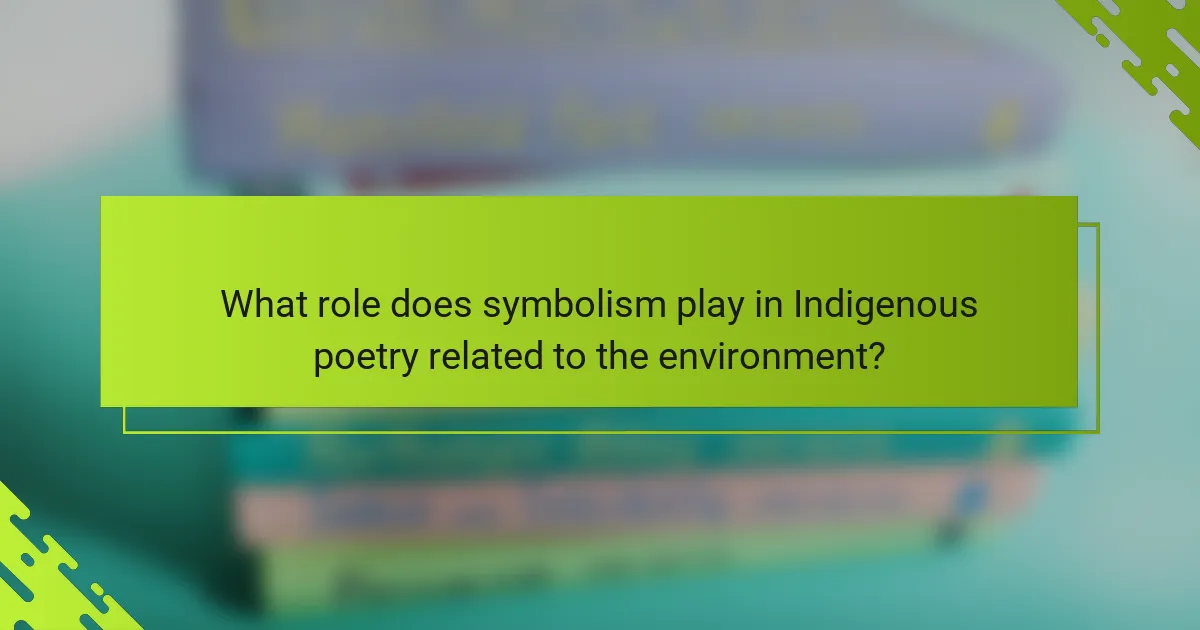
What role does symbolism play in Indigenous poetry related to the environment?
Symbolism in Indigenous poetry profoundly connects cultural identity to environmental themes. It conveys respect for nature, illustrating the interdependence between people and the land. Symbolic elements often reflect unique attributes of specific ecosystems, emphasizing their sacredness. This poetic approach fosters a deeper understanding of environmental stewardship and cultural heritage.
How do animals and plants symbolize environmental relationships?
Animals and plants symbolize environmental relationships by representing interconnectedness and balance within ecosystems. Indigenous poetry often highlights these symbols to convey respect for nature and emphasize the importance of sustainable practices.
For example, animals may symbolize strength and resilience, while plants can represent growth and nourishment. These representations foster a deeper understanding of the symbiotic relationships that sustain life.
Furthermore, the unique attributes of specific species are often woven into narratives, illustrating their roles in cultural identity and ecological stewardship. This approach not only celebrates biodiversity but also reinforces the spiritual connection between communities and their environments.
Ultimately, these themes in Indigenous poetry advocate for environmental awareness and the preservation of natural habitats, encouraging a holistic view of nature as a living entity deserving of respect and protection.
What are some unique symbols found in specific Indigenous poetic traditions?
Unique symbols in Indigenous poetic traditions often reflect deep connections to nature and cultural identity. Symbols like the eagle represent strength and freedom, while the river signifies life and continuity. The use of the moon symbolizes guidance and cycles of life. Additionally, the bear embodies courage and introspection. These symbols convey environmental themes, emphasizing harmony with the land and spiritual relationships. Such representations are unique to specific tribes, showcasing their distinct cultural narratives within the broader context of Indigenous poetry.
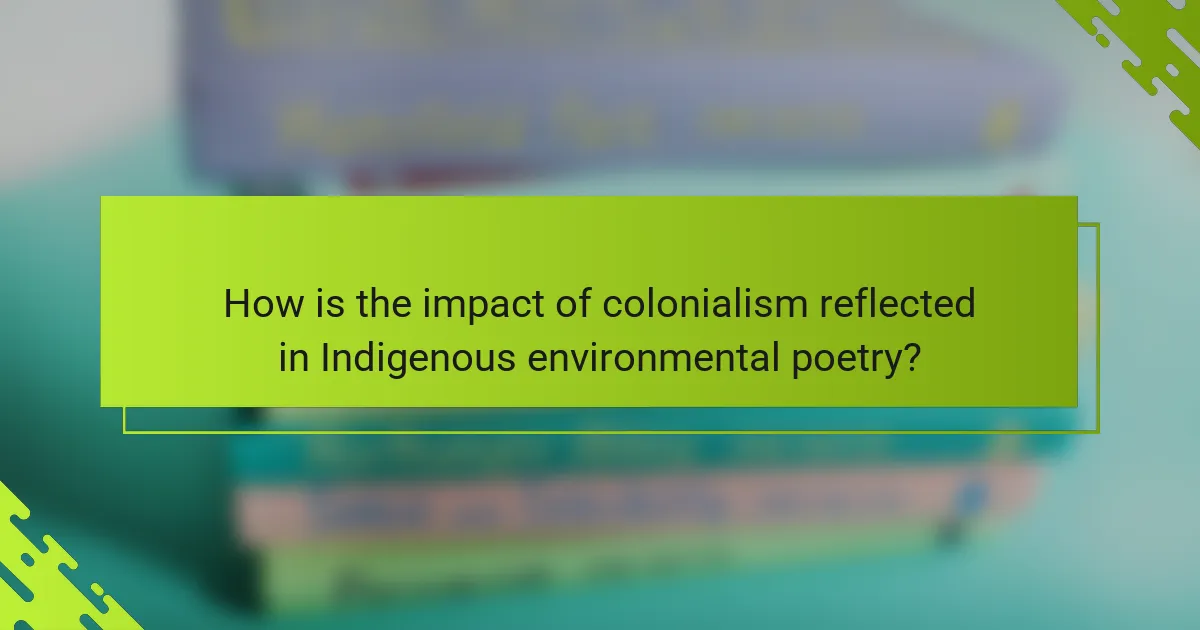
How is the impact of colonialism reflected in Indigenous environmental poetry?
The impact of colonialism is profoundly reflected in Indigenous environmental poetry through themes of loss, resilience, and reclamation. These poems often express a deep connection to land and nature, highlighting the disruption caused by colonial practices. Indigenous poets use vivid imagery to portray the spiritual and cultural significance of their environments, emphasizing the need for healing and restoration. The unique attribute of this poetry lies in its ability to blend traditional ecological knowledge with contemporary issues, creating a powerful narrative that critiques colonialism while advocating for environmental justice.
What themes of resilience and resistance emerge in response to environmental degradation?
Indigenous poetry often highlights resilience and resistance against environmental degradation through powerful imagery and cultural narratives. These themes manifest in the celebration of nature, the assertion of traditional ecological knowledge, and the call for environmental justice.
Poets articulate the deep connection between their communities and the land, emphasizing the importance of preserving natural resources. This relationship serves as a foundation for resistance against exploitation and environmental harm. Additionally, the use of oral traditions in poetry reinforces collective memory and cultural identity, fostering a sense of unity in the fight for environmental preservation.
Moreover, unique attributes of Indigenous poetry include the blending of spiritual beliefs with environmental themes. This synthesis underscores the sacredness of the land and the need for stewardship. As a result, Indigenous voices amplify calls for action, urging society to recognize the interconnectedness of all life and the urgent need to combat ecological degradation.
Which poets specifically address historical injustices in their environmental themes?
Several poets address historical injustices within their environmental themes, particularly Indigenous poets. For instance, Joy Harjo explores the impact of colonization on land and identity. Similarly, Linda Hogan emphasizes the connection between environmental degradation and cultural loss. These poets highlight the intersection of ecological issues and social justice, bringing attention to the historical narratives that shape contemporary environmental challenges. Their works serve as powerful reminders of the ongoing struggles faced by Indigenous communities in relation to their lands.

What contemporary issues are addressed in Indigenous environmental poetry?
Indigenous environmental poetry addresses contemporary issues such as climate change, land rights, and cultural preservation. These themes highlight the connection between Indigenous identity and environmental stewardship. Poets express concerns over ecological degradation, promoting a message of sustainability and respect for nature. This genre often emphasizes the unique relationship Indigenous peoples have with their land, advocating for ecological justice and awareness.
How do climate change and environmental activism feature in recent works?
Recent works of Indigenous poetry prominently feature climate change and environmental activism, emphasizing the deep connection between cultural identity and ecological stewardship. These poems often reflect unique attributes of Indigenous perspectives, highlighting the impacts of climate change on traditional lands and practices.
For example, many poets use vivid imagery to depict the loss of biodiversity and the urgency of environmental action. They advocate for sustainable practices rooted in ancestral knowledge, illustrating how Indigenous wisdom can inform contemporary environmental movements.
Moreover, the poetry serves as a rare platform for Indigenous voices, merging art with activism to address pressing ecological issues. This intersection of art and advocacy not only raises awareness but also fosters a sense of community and resilience among Indigenous peoples facing environmental challenges.
Which modern Indigenous poets are leading the conversation on environmental themes?
Contemporary Indigenous poets such as Joy Harjo, Ocean Vuong, and Natalie Diaz are at the forefront of environmental themes in their work. They explore the interconnectedness of nature and culture, emphasizing the importance of land and ecological preservation.
Joy Harjo, the first Native American Poet Laureate of the United States, often reflects on the relationship between Indigenous identity and the environment. Her poetry highlights the sacredness of nature and the urgency of environmental stewardship.
Ocean Vuong, while not Indigenous himself, engages deeply with themes of displacement and belonging, resonating with Indigenous narratives about land and identity. His work often underscores the impact of environmental degradation on personal and communal histories.
Natalie Diaz focuses on the Mojave landscape, using her poetry to advocate for water rights and the survival of Indigenous cultures. Her unique perspective connects environmental issues to the broader struggle for Indigenous rights and recognition.
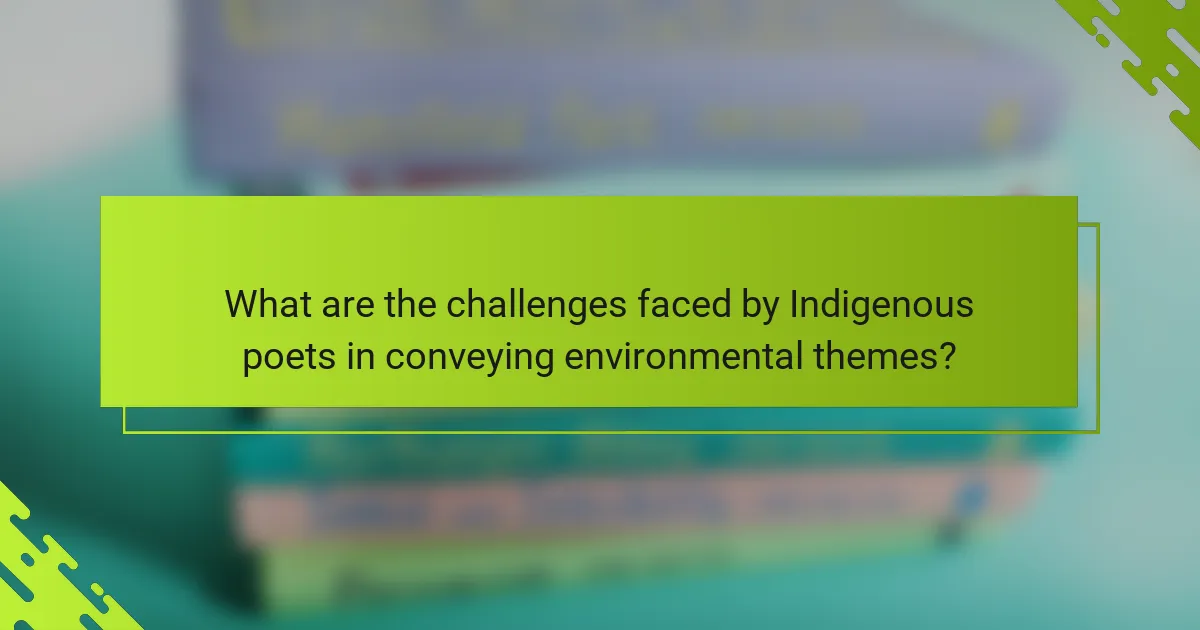
What are the challenges faced by Indigenous poets in conveying environmental themes?
Indigenous poets face significant challenges in conveying environmental themes. These include cultural misrepresentation, limited access to publishing platforms, and the struggle to balance traditional knowledge with contemporary environmental issues. Additionally, language barriers can hinder the expression of nuanced ecological concepts inherent in Indigenous cultures.
How do language barriers affect the dissemination of Indigenous poetry?
Language barriers significantly hinder the dissemination of Indigenous poetry by limiting access and understanding. These barriers can obscure cultural nuances and environmental themes, making it difficult for broader audiences to appreciate the depth of Indigenous voices. Translation challenges often result in the loss of unique attributes inherent in the original language, which can diminish the emotional impact and cultural significance of the poetry. Additionally, the lack of representation in mainstream literary spaces further restricts the reach of these vital narratives, preventing Indigenous perspectives on environmental issues from resonating widely.
What are common misconceptions about Indigenous environmental narratives?
Common misconceptions about Indigenous environmental narratives include viewing them as solely historical or romanticized. Many people underestimate the contemporary relevance of these narratives in addressing modern environmental issues. Additionally, there is a tendency to generalize Indigenous perspectives, overlooking the diversity of voices and experiences across different tribes. Some may also believe that Indigenous knowledge lacks scientific validity, despite its empirical basis and practical applications in sustainable practices. Finally, the idea that Indigenous environmental narratives are static fails to recognize their dynamic nature and ongoing evolution in response to current ecological challenges.
What strategies can Indigenous poets employ to reach wider audiences?
Indigenous poets can reach wider audiences by utilizing social media platforms, collaborating with diverse artists, and participating in literary festivals. These strategies enhance visibility and foster connections with broader communities. Social media allows for direct engagement, while collaborations introduce Indigenous perspectives to new audiences. Literary festivals provide platforms for live performances and networking, amplifying the voices of Indigenous poets.
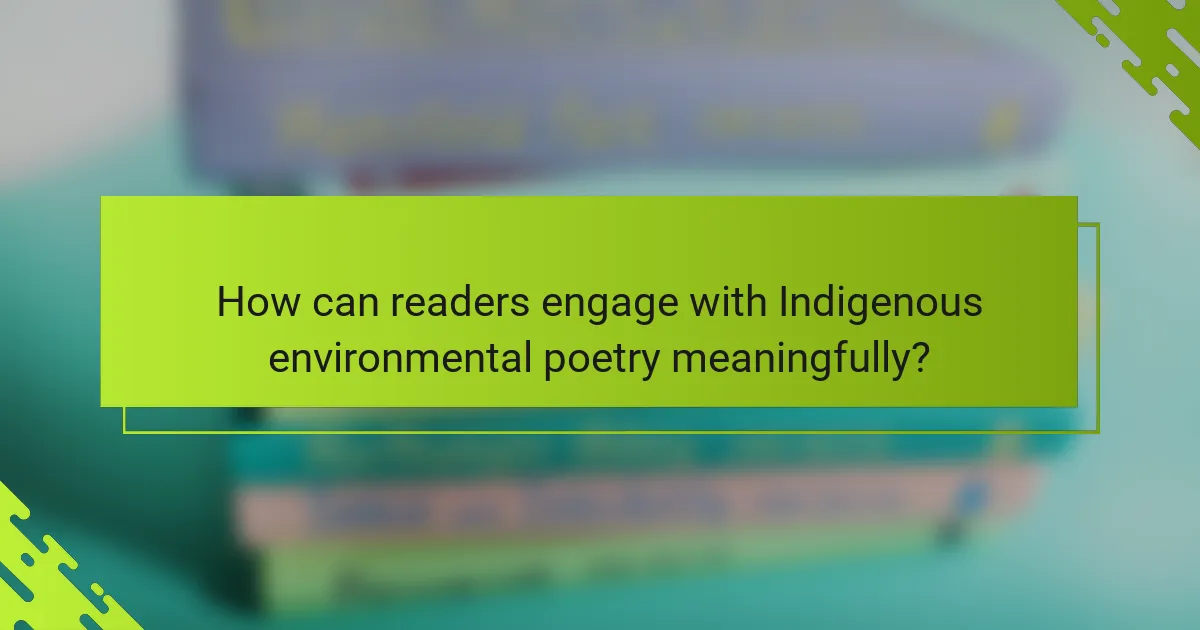
How can readers engage with Indigenous environmental poetry meaningfully?
Readers can engage with Indigenous environmental poetry by reflecting on its themes and cultural significance. This poetry often emphasizes interconnectedness with nature, highlighting Indigenous knowledge and ecological wisdom.
Active participation includes attending readings, discussions, and workshops led by Indigenous poets, fostering a deeper understanding of their perspectives. Analyzing specific poems can reveal unique attributes, such as the use of traditional language or symbolism, which enhances appreciation.
Readers should also explore the historical context of the poetry, recognizing the rare experiences and challenges faced by Indigenous communities. Engaging with these texts meaningfully requires respect, openness, and a willingness to learn from diverse cultural narratives.
What are the best practices for interpreting the themes in Indigenous poetry?
To effectively interpret themes in Indigenous poetry, focus on cultural context, symbolism, and connection to nature. Recognizing the deep relationship between Indigenous peoples and their environment is crucial.
Consider the use of metaphors that reflect ecological wisdom. For example, many poets illustrate the interdependence of life forms, emphasizing sustainability. Analyze how personal and communal narratives intertwine with environmental themes.
Pay attention to the unique attributes of specific Indigenous cultures, as each may have distinct ecological perspectives. This diversity enriches the overall understanding of environmental themes in their poetry.
Lastly, engage with the poetry through a lens of respect and openness, allowing the voices of Indigenous authors to guide your interpretation. This approach fosters a deeper appreciation of their environmental insights.
How can educators incorporate Indigenous poetry into environmental studies?
Educators can effectively incorporate Indigenous poetry into environmental studies by focusing on the interconnectedness of nature and culture. This poetry often emphasizes themes of sustainability, respect for the land, and the spiritual relationship between people and the environment.
Utilizing Indigenous poetry can foster critical thinking about environmental issues. For example, educators can analyze poems that reflect traditional ecological knowledge, highlighting unique perspectives on conservation. This approach enriches students’ understanding of environmental stewardship.
Engaging students with Indigenous poets can also promote discussions around cultural identity and environmental justice. By exploring the historical context of these works, educators can illustrate the impact of colonization on Indigenous lands and communities.
Incorporating creative assignments, such as writing responses or creating art inspired by the poetry, allows students to express their interpretations of environmental themes. This method not only enhances learning but also respects and honors Indigenous voices in the conversation about environmental studies.
What common mistakes should readers avoid when analyzing Indigenous environmental themes?
Readers should avoid oversimplifying Indigenous environmental themes in poetry. Misinterpretation often arises from neglecting cultural context and the specific experiences of Indigenous communities. Failing to recognize the unique attributes of these themes can lead to a superficial understanding. Additionally, readers should be cautious of projecting their own values onto the poetry, which may distort the original message. Engaging with the work through a lens of respect and openness is essential for a genuine analysis.
